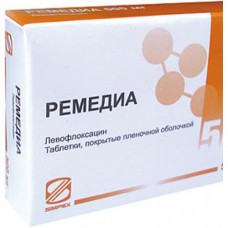Expiration date: 05/2026
Composition
1 tablet contains: levofloxacin (hemihydrate) 500 mg.
Packaging
Pack of 5 PCs.
Pharmacological action
Of remedia is a fluoroquinolone, an antimicrobial germicide of wide spectrum of action. Does DNK-girazu (topoisomerase II) and topoisomerase IV, violates supercoiling and cross-linking of DNA breaks, inhibits DNA synthesis, causes profound morphological changes in cytoplasm, cell wall and membranes. Effective against Enterococcus faecalis, Staphylococcus aureus, Staphylococcus epidermidis, Streptococcus pneumoniae, Streptococcus pyogenes and Streptococcus agalactiae, Viridans group streptococci, Enterobacter cloacae, Enterobacter aerogenes, Enterobacter agglomerans, Enterobacter sakazakii, Escherichia coli, Haemophilus influ?nz??, Haemophilus parainfluenzae, Klebsiella pneumoniae, Klebsiella oxytoca, Legionella pneumoniae, Moraxella catarrhalis, Proteus mirabilis, Pseudomonas aeruginosa, Pseudomonas fluorescens, Chlamydia pneumoniae, Mycoplasma pneumoniae, Acinetobacter anitratus, Acinetobacter baumannii, Acinetobacter calcoaceticus, Bordetella pertussis, Citrobacter diversus, Citrobacter freundii, Morganella morganii, Proteus vulgaris, Providencia rettgeri, Providcncia stuartii, Serratia marcescens, Clostridium perfringens.
Testimony
Infections caused by sensitive to levofloxacin pathogens: lower respiratory tract (acute exacerbation of chronic bronchitis, community-acquired pneumonia), acute sinusitis, urinary tract and kidneys (including pyelonephritis), skin and soft tissue, chronic bacterial prostatitis, septicemia/bacteremia (associated with referred to earlier indications), intraabdominal infection, tuberculosis (complex therapy of drug-resistant forms).
Contraindications
Hypersensitivity, epilepsy, lesions of the tendons at the earlier treatment quinolones, pregnancy, lactation, childhood and adolescence (up to 18 years).
With caution the elderly (high probability of having a concomitant loss of kidney function), the deficit glukozo-6-fosfatdegidrogenaza.
Application of pregnancy and breastfeeding
Levofloxacin is contraindicated during pregnancy and lactation (breastfeeding).
Method of application and doses
Inside, before meals or in between meals, not liquid, squeezed enough liquid. In/in slowly.
Acute sinusitis - 500 mg 1 time per day for 10-14 days.
Exacerbation of chronic bronchitis - on 250-500 mg of 1 times a day for 7-10 days.
In community-acquired pneumonia - 500 mg 1-2 times a day for 7-14 days.
In uncomplicated urinary tract infections - 250 mg 1 time per day for 3 days.
In complicated urinary tract infections - 250 mg 1 time per day for 7-10 days.
When infections of skin and soft tissues inside of 250-500 mg 1-2 times per day, in/in, 500 mg 2 times a day for 7-14 days.
When septicemia/bacteremia - 500 mg 1-2 times a day for 10-14 days.
When intraabdominal infections - 500 mg 1 time per day for 7-14 days (in combination with antibacterial drugs acting on the anaerobic microflora).
In chronic bacterial prostatitis - 500 mg 1 time a day for 28 days.
Tuberculosis (complex therapy) 500 mg 1-2 times a day, treatment course - up to 3 months.
After the on/in the introduction in a few days, a transition to the ingestion of the same dose.
In diseases of the kidney dose reduced in accordance with the degree of violation of their functions: at CC 20-50 ml/min - on 125-250 mg 1-2 times per day, 10-19 ml/min - 125 mg 1 time per 12-48 h, less than 10 ml/min (including hemodialysis) - 125 mg every 24 or 48 hours.
Side effects
From the digestive system: nausea, vomiting, diarrhea (including blood), indigestion, loss of appetite, abdominal pain, pseudomembranous colitis, increased activity of "liver" transaminases, hyperbilirubinemia, hepatitis, goiter.
By SSS: reducing AD, vascular collapse, tachycardia, prolongation of the interval Q-T.
From the metabolic: hypoglycemia (increased appetite, increased sweating, tremors).
From the nervous system: headache, dizziness, weakness, drowsiness, insomnia, tremor, anxiety, paresthesia, fear, hallucinations, confusion, depression, movement disorders, seizures.
From the sensory organs: visual impairment, hearing, olfactory, gustatory and tactile sensitivity.
From the side of musculoskeletal system: arthralgia, muscular weakness, myalgia, tendon rupture, tendonitis.
From the urinary system: gipercreatininemia, interstitial nephritis, acute renal failure.
The bodies of the blood: eosinophilia, hemolytic anemia, leukopenia, neutropenia, agranulocytosis, thrombocytopenia, pancytopenia, hemorrhage.
Allergic reactions: photosensitization, itching and redness of the skin, swelling of skin and mucous membranes, hives, malignant exudative erythema (Stevens-Johnson syndrome), toxic epidermal necrolysis (Lyell's syndrome), bronchospasm, dyspnea, anaphylactic shock, allergic pneumonitis, vasculitis.
Other: asthenia, exacerbation of porphyria, rhabdomyolysis, persistent fever, development of superinfection.
Special instructions
After normalization of body temperature is recommended to continue the treatment for at least 48-78 hours
Long in/in infusion 500 mg (100 ml of infusion solution) should be at least 60 min.
During treatment you must avoid sunlight and artificial UV radiation to avoid damage to the skin (photosensitization).
When signs of tendinitis, pseudomembranous colitis levofloxacin immediately cancelled.
It should be borne in mind that patients with brain damage in medical history (stroke, severe injury) may develop convulsions, in case of insufficiency of glucose-6-phosphate dehydrogenase - the risk of hemolysis.
Severe community-acquired pneumonia caused by Streptococcus pneumoniae, levofloxacin may not provide the optimal therapeutic effect.
During the period of treatment must be careful when driving and occupation of other potentially hazardous activities, require high concentration and psychomotor speed reactions.
Drug interactions
Increases T1/2 cyclosporine. Effect reduce drugs that inhibit intestinal motility, sucralfate, Al3+ and Mg2+-containing antacid drugs and salts of Fe (a break between the reception of at least 2 hours). NSAIDs, theophylline increases the risk of seizures, corticosteroids increase the risk of tendon rupture. While the use of indirect anticoagulants, coumarin derivatives required INR monitoring. Cimetidine and drugs that block tubular secretion, and slow excretion. Solution for the on/in the introduction is compatible with 0.9% NaCl, 5% dextrose, 2.5% ringer solution with dextrose, combined solutions for parenteral nutrition (amino acids, carbohydrates, electrolytes). Should not be mixed with heparin and solutions having an alkaline reaction.
Overdose
Symptoms: nausea, erosive lesions of the mucous membranes of the gastrointestinal tract, lengthening of interval Q-T, confusion, dizziness, seizures.
Treatment: symptomatic, dialysis is ineffective.


